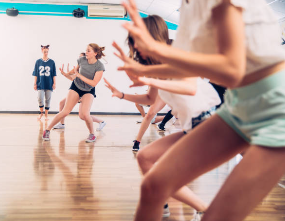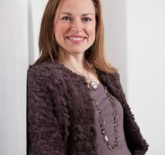Can't Miss Dance Activity: Step by Step

Previously published in Volume 81, Issue 3
Teaching dance can be intimidating, but it doesn’t have to be choreographed or full of complicated steps.
The dance exercise “three times three” (detailed, below) is an opportunity for kids to take the lead. They get to explore within the loose guidelines, exercise their creativity and then share their creation with others, which gives them a sense of accomplishment and ownership.
This activity can work well outside the gym, too. It can be a great break from sitting in the classroom, or used on days when kids can’t go outside.
Getting started
Music suggestions: Femi Kuti (African), This Will Destroy You (instrumental), Anoushka Shankar (fusion East Indian), Bobby McFerrin Circle Songs (a capella vocals)
During this activity, students will create three contrasting shapes with their bodies. I like to divide them into low, medium and high shapes.
-
Students spread out into their own space, standing in neutral position: feet comfortably apart, arms at sides, head on top of spine and eyes gazing forward. They will always come back to neutral in this exercise.
-
Say, “On the count of three, show me a low shape. One, two, three!” Clap when you say three and then look at the shapes that they’ve made. Ask them to be frozen in this shape.
-
Give them a little coaching to make the shape is different from their neighbours’ shapes and ask them to make sure it’s a shape they can hold for a long time (no standing on their heads, for example).
-
Ask them to memorize this low shape. Notice where their hands are, where their feet are, where they’re looking, how their spine is. Tell them that this shape is called A.
-
Ask them to return to neutral. Then say, “On the count of three, go to shape A. One, two, three.” Have them hold it for a few seconds and then return to neutral.
Keeping it fun
At this point, it’s a good idea to initiate a little bit of a conversation. Too often, dance is an internal experience and we never find out what’s going on in our students’ heads. Asking some questions and hearing the answers from a few students is an incredibly valuable experience.
It shows students that they are not the only ones going through the exercise. When they hear about each other’s struggles or successes, it expands their experience and creates a sense of community.
As they are standing in neutral, ask, “Did anyone forget what their A shape was?” Remind them that this exercise is not about getting it right, it’s about being creative and seeing what shows up in their bodies. Encourage them to be brave and share their answers.
Generally, someone will say they forgot their shape. Then ask, “What did you do?” They’ll usually reply that they made up a new one. Acknowledge their courage to answer and to make up a new shape. Dance doesn’t have to be about getting it right. It can be about acting quickly, enhancing decision-making skills and being brave, which are all important life skills too.
-
After the brief chat, it’s time to go back to neutral. Repeat the A shape again and then return to neutral.
-
Next, ask them to make a new shape at a medium height. Remind them to make it interesting and unique. Count to three and have them freeze. Call this shape B. Have them hold the shape for a few seconds, checking to see if they can stay frozen and making sure it’s different from their neighbours’ shapes. Let them know that making adjustments is welcome.
-
Get them to memorize this B shape by noticing where their arms, hands, legs, feet, back and head are. Then they can relax.
Mixing it up
Now play a little bit with the two shapes they have. Count to three and call out either neutral, A or B. It becomes a bit of a game and they like the challenge. Mix it up and have fun with it.
-
Once they’ve got those two shapes, add in a high shape. Repeat the same process and call the high shape C.
-
Here’s where it gets interesting and you can start to play with tempo. Keep the sequence the same — neutral, A, B, C, neutral — and ask the students to go pose to pose in eight counts, which is slower than they’ve been doing it so far. Clap and count to eight. Let them know that they should be moving from one shape into the next one for the whole eight counts, then freeze on count eight.
-
Next, try it in super slow motion, taking sixteen counts in between each pose. Then, do the same thing but with only four counts in between each pose. You’ll see faces light up as students are challenged. Now decrease the counts to two for even more of a challenge.
-
Finally, repeat the sequence with only one count in between each shape. This is really fun to watch. Students will feel exhilarated and proud of themselves.
Asking and sharing
They may be a little out of breath at this point, so it’s a great time to initiate another conversation. Ask questions such as:
-
Which tempo was the easiest for you?
-
Which tempo was the most challenging?
-
Did you ever forget your shape? What did you do?
Tell students you need at least three people to answer each question before the class moves on. Once they get the hang of sharing their thoughts, the discussion can get really interesting.
Taking it to the next level
You can stop there, or you can continue with this next section.
-
Invite students to move however they want to get to each shape. Using the same sequence, count and clap for eight beats in between. Tell them that they can spin, wave their arms, move their legs, and essentially do whatever they want as long as they hit the next pose on eight.
-
From there, I like to give them the opportunity to teach each other. Have them find a partner. Each partner gets a chance to teach their sequence to their friend. By the end, they will have a combined sequence of neutral, then poses A, B, C from partner 1, then poses A, B, C from partner 2, and finishing with a new, unique pose instead of neutral.
-
Give them a few minutes to practice and let them know that they will get to show their work to the class at the end. This performance gives them accountability and focus.
Presentation tips
For the presentation, split the class in half, grouping them into performers and audience. Performers get to choose which direction they face, so they can even have their backs to the audience if they’re feeling nervous, or they can face the audience or each other. They can also choose where they will stand in their half of the room.
Remind them to go through the sequence: neutral, A, B, C, A, B, C, end pose. Before the performance, go through audience manners. Each member of the audience is expected to:
-
Focus on the performers
-
Stay silent
-
Face the performers with your whole body
-
Applaud wildly at the end because we appreciate and honour the performers’ courage
I also ask the audience to watch for something that surprises them, something that captures their attention or something they really like.
Before the performers begin, remind them to start in neutral, to go through the sequence and to finish in their end pose. They can either hold the end pose or go into neutral and hold that until everyone is done.
Have the performers do their sequence and then ask the audience:
-
What was something that surprised you?
-
What was something that captured your attention?
-
What was something you really liked?
Aim for three answers for each question. Then you can ask the performers:
-
How did you feel when you were performing?
-
Did everything go as planned?
-
What are you most proud of right now?
After the questions have been answered, have the audience members and performers switch positions and repeat the performance and questions.
The payoff
Students get to take ownership of their work, they experience creativity, they learn that mistakes are part of the learning process, they practice following instructions, and they collaborate and overcome fears.
Best of all, you need no training to implement the activity. Just follow the directions outlined here and then see how you can modify the exercise.
Multi-subject applications
Imagine the cross-curricular possibilities. Incorporate symmetrical/asymmetrical shapes for math. Talk about different vocabulary words for the qualities of the shapes such as twisted, wide, tight, open, closed, balanced and askew. Play with different types of music from various cultures and see how they affect the quality of the movement.
Teachers and students are likely to enjoy this activity equally. For students, it’s a chance to explore movement and expression, and have fun. For teachers, it’s a chance to get to know students on a different level and to strengthen the bonds within the group.








